“I promise to uphold human dignity and actively oppose efforts to diminish people, threaten them or humiliate them, whether such attempts stem from the state or local government level, the media or business world.”
(President Toomas Hendrik Ilves’s inauguration speech Oct. 10 2011)
“Lies have always been regarded as necessary and justifiable tools not only of the politician’s and the demagogue’s but also of the statesman’s trade.”
(Hannah Arendt, 1967)
“Such Truth, as opposeth no man profit, nor pleasure, is to all men welcome.”
(Thomas Hobbes, Leviathan, 1651)
How do we know whether what we read and hear is true, and does it matter? How, in the endless flow of information available through media, social networks and the rest of the Internet, can we find facts and separate them from opinions, or plain lies?
Infowars and psyops have become a hot topic recently. This does not mean that biased reporting, propaganda and deliberate distortion of facts is something new. Growing up in Soviet-occupied Estonia I learned early on that printed news could not be trusted. Still we believed that once we’d have press freedom, lies and propaganda would be traded for valid info and intelligent analysis. Turns out it is not that easy.
In the free world, people tend to take for granted that what mass media says is more or less true. Now the Internet makes things more complicated. The plentitude of blogs, online forums and social media means that people can more easily find what they’re looking for, not just information, but also soulmates, who offer confirmation of opinions one already holds. It also means a blurring of the line between professional and amateur media, fact check or none – blog entries can be written more professionally than texts in institutionalized media outlets, but they can also promote conspiracy theories or fantasies that some readers will be convinced is the real truth. “An alternative to official propaganda” has become a trademark self-description of some state-sponsored professional propaganda channels such as the Russian RT and its smaller clones. All this means that today’s information landscape requires more alert judgment from its user than any media, censored or not, did before.
Cass Sunstein, a top US legal scholar and philosopher, has written a pamphlet, “On Rumours”, in which he explains why people tend to believe rumours even if they are false: a certain group of people believes them because they are predisposed to doing so, because the rumours confirm their own prejudices or assumed opinions. As a next step, Sunstein cites group pressure: it has been demonstrated by experiments that people are more prone to believing something when they see that others believe it. So if there is a first group of willing believers, others are likely to follow – the more believers there are, the more the rumour, true or false, is spread and believed.
Sunstein, however, does not mention one important factor. It is our sense of reality, the precondition of sanity. Yes, in the Soviet Union we assumed that papers lie – but that, too, was a kind of certainty, a fact of the world. In the free world, people mostly do not expect to be lied to, by media or by other people. Otherwise exchanging information would just not make any sense. We may doubt some details or dislike the attitudes of commentators, but people assume the facts given to them are true. If we had an attitude that all the info we receive might be or not be true, on a fifty-fifty-basis, we’d lose our sense of reality and a faith in the meaning of communication.
Sunstein also explains, and to an extent endorses, the view that the freedom of speech protects the right to lie. The argument says that the freedom to speak implies a chance to err, and if the cost of an error is too high, the freedom of speech is limited. Still, there should be incentives for at least professional journalists to check their sources and to avoid deliberate lies, exactly because people tend to believe what they read and therefore, published false information can cause real damage. Freedom of speech also includes the right to acquire information, and if the task to check the facts is left entirely to the reader, that right of the reader is compromised.
Peter Pomerantsev has shown in his book “Nothing is True and Everything is Possible” that in an information space filled with lies the concept of truth becomes meaningless. The worst then is not that we get wrong information, but that with enough “alternative truths” out there we fail to get any information at all. When nothing is true, everything is possible. British libel laws have been criticized for being too punitive for revealing any information uncomfortable for anyone who can afford to sue the speaker. But if public lying contains no risks at all, or if systematic lies constitute a massive, deceitful information industry like they do in today’s Russia, then information ceases to be a means to make sense of the world, it becomes a means to create the world. This was noticed long before our current discussions on information wars by Hannah Arendt, who wrote in the 1950s that the worst thing about totalitarian propaganda was not that it did not correspond to reality, but that it was instrumental in creating a reality that more and more resembled its fiction.
I had the bad luck of personally becoming a guinea pig to test the power of information warfare that proved amazingly efficient. The protections an individual has against libel in most free countries do not apply to you if you are slandered as a part of an institution and your hands are tied in that role. In such a case, if the institution fails to protect its members, the smeared individual has no protection whatsoever. I paid for someone’s lies with my job, my reputation, my dignity.
*
In Estonia today, the press is as free as it can be. While occupied by the Soviets from WWII to 1991, the country had created a divided mental space where people in private spheres defied the official “truth” and lived on the memories of their elders and the information they got through a limited access to Western media. Now, Estonia ranks high in international indexes of free speech and Internet freedom. One can say anything and there is a downside to it: the quality standards that the free but poor media of the small country sets itself are not very high.
Soviet propaganda was simpler and more transparent compared to current, more sophisticated disinformation techniques. But ideology was only part of its arsenal. As stated by Yuri Bezmenov, a deserted KGB officer in a video interview from 1984, opinion formation was a more important task for their organisation than spying. The goal of info-ops was not just to paint the Soviet Union in rosy and the “imperialist West” in dark tones. Information attacks were used to smear and eliminate people whom the regime did not like, elevate and praise the ones it did. They could break families, interrupt careers, make or destroy leaders – not just at home, but through the right contacts also in the West. (As just one example of the methods used, the Nobel-winning author Herta Müller was smeared by the Romanian Securitate as their own spy when she moved to Germany, to undermine the Germans’ trust toward her.)
Many people have wondered why the President of Estonia, Toomas Hendrik Ilves, hired a public relations adviser who had worked, as he has openly admitted, for the KGB in the 1980s – Toomas Sildam. One possible explanation is that the art of making things look like you want them to look is useful for politicians in any regime.
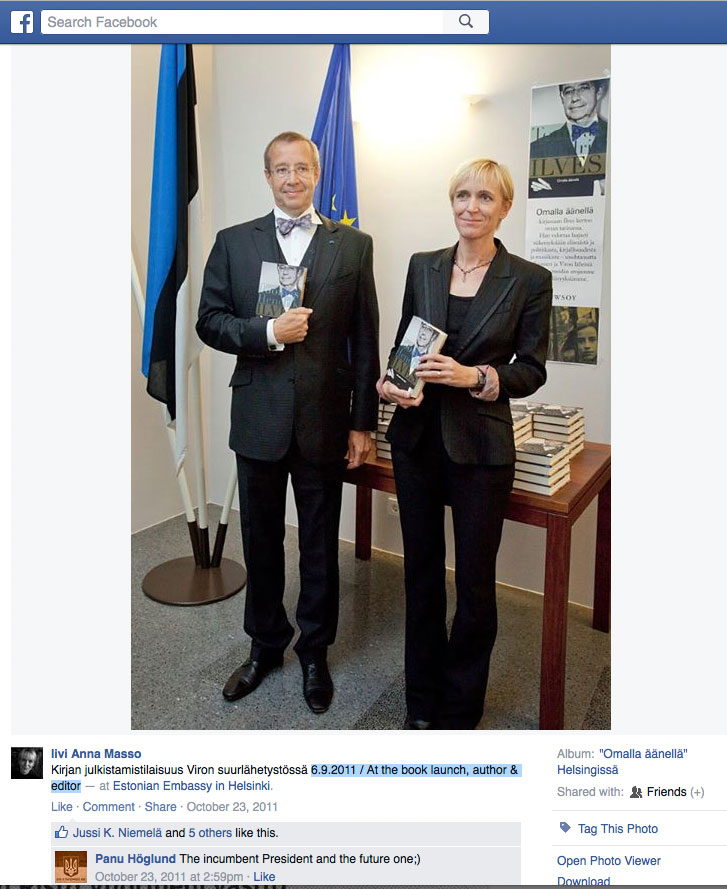
I worked with the two Toomases for two years, two months and two days. One was my colleague and the other, the President, my boss. Indeed I worked with the President a little longer – before he hired me as his adviser, I edited his book, a collection of essays with an interview introducing his worldview, published by the Finnish WSOY in 2011 (later also published in Estonian and Latvian). As I’d interviewed him for Finnish media, the President found I’d asked the right questions and understood his answers. Thus I was trusted to support his intellectual work full time. I started working at the President’s office, called the Castle, in the beginning of 2013; the contract was to last till the end of Ilves’ second term in office, October 2016.
However, on March 2, 2015 I was summoned by the Director of our office, Siim Raie, from a routine staff meeting, coerced to sign papers about the immediate termination of my position – I was threatened to be thrown out by force by armed security police if I refused to sign – and escorted out of the Castle, with no reason given, no chance to talk to anyone. My mailbox had already been closed behind my back, my computer emptied of work-related materials. I was thrown out of my workplace like a criminal.
I never understood exactly what the role of my colleague, the PR adviser, was in the course of events that led to this. But I did realize I had become an example of what rumours and lies, professionally used, can do to a person, a reputation, a career, a life.
*
I heard the first false rumour about myself while working in the Castle in summer 2013. Then a colleague claimed he had heard that I was applying for the post of editor-in-chief of Sirp, a weekly culture magazine. The position was indeed open for application at the time, but I had not even thought of applying. It appeared someone had an interest in creating the impression that I was not committed to my current job.
It wasn’t the first time I was a target of malicious rumours. In 2008, when a small but noisy pro-Kremlin group in Finland, led by Johan Bäckman, later a self-described “representative of Finland to the Donetsk Republic”, launched an information campaign against Estonia, denying its Soviet occupation and calling it a Fascist apartheid regime, I joined some other Estonians and Finns in a protest. As a result, the group launched personal campaigns against me and others, calling us Nazis, Fascists, etc. – a revival of familiar Soviet-era Kremlin vocabulary. The campaign went on in the Finnish blogosphere for years, until the attention of the group shifted to Ukraine. This campaign was purely political, an attempt by professional propagandists to label their perceived enemies. The one that was to follow was different, more personal. And it started in Estonia, possibly right inside the Castle.
The first rumour, the one about me applying for a post that I did not apply for, was quickly forgotten. I kept working hard, doing my best to support the President.
I received the first signal about the next rumour in an e-mail on April 15 2014. I was approached by the Estonian glossy gossip weekly, Kroonika. They asked me to confirm – meaning that someone had told them – that I was having a “love affair” with the President. This came totally out of the blue. The question was so absurd I first thought it wasn’t worth a reply. Then it dawned to me that they might actually write something like that and my silence could be seen as a failure to deny. So I did what I had been instructed to do about any media publicity regarding our office. I showed the e-mail to the President’s Public Relations adviser, Toomas Sildam, and asked him what to do. He told me to reply lightly, as if in passing, that “April Fools’ Day is already gone”. I followed his advice only partly. I told the magazine we had mostly female staff in the Castle and suggesting that the married President was having an affair with any staff member insulted all of us. I didn’t see it as more personal than that.
Two days later, on April 17, Kroonika published a cover story on the President’s marriage, claiming it was falling apart and pointing to me as the reason. It clearly led the reader to believe that I was having an affair with my boss; it described me as a femme fatale donning long legs with short skirts in the office (in fact, I was the only female staff member who always wore pants as long as the dress code allowed it, sometimes mocked by colleagues for my minimalist taste). The magazine claimed, citing “the President’s close inside circle” as an anonymous source, that the first couple’s relationship had gone sour since I’d been hired to work in the Castle.
Within days, nearly all Estonian papers carried headlines insisting I was having a love affair with the President. The “news” traveled fast, and many people believed it. Family and friends called from Estonia and abroad to ask what was up. When I visited my mother in a Tallinn suburb, her neighbour joked about calling the paparazzi to meet me. He added, casually, that a friend of his, a gossip journalist Anu Saagim, had “known it” for months – that is, months before I myself caught the news. Some of the papers mentioned briefly that I had denied it, rushing to add that “people close to the President” knew better, thus making me not only my boss’s mistress, but also a liar.
*
The next workday – there was a tortuous weekend in-between – I expected some reaction in the Castle, a discussion about what to do. After all, it was not about me – the media all over Estonia were falsely claiming that the married President of the Republic was having an affair with an employee of his. Some people might think such claims would need to be corrected. But it turned out my colleagues did not think so. No one wanted to discuss the case. The PR adviser who was responsible for the public image of the President and the Castle, spoke to me like to a child, in a lulling and patronising tone, trying to make me understand that no one read those insignificant gossip papers: we shouldn’t make things official by reacting to them. Some colleagues hinted that this kind of “scandals” were sometimes made up in order to cover up something else. Others insisted that it must be an inside job. “Look who is smiling to you most sweetly”, someone said, “they could be the ones spreading the gossip”.
I talked to some journalist friends and lawyers. It looked like I wouldn’t be able to afford lawyers’ fees, given the level of compensation for libel in Estonia. Raie, the director, declared: “The President’s office does not go to court against our people”. My hands were tied, I had no authority to issue a statement on behalf of our office. I could only write to the editors and ask them to take their online stories down – that, too, was actually the Public Relations adviser’s job, but he did not do it. Later the fact that I’d done it myself was repeatedly cited in papers as if it proved my “guilt”. The editors did take the libelous stories down, but the damage was already done. The paper version of Kroonika was on sale for a week, and as I discovered much later, the headline in Estonia’s biggest daily Postimees, “Iivi Anna Masso and Toomas Hendrik Ilves – a sizzling love affair?” had remained online after the story was removed, it had been multiplied in different forums and it decorated the first page of the Google search of my name for more than a year. The editor-in-chief of Kroonika, Krista Lensin, replied to my protests: “You did not ask us to not publish the piece!” How could I have done so, when I had absolutely no idea about it coming?
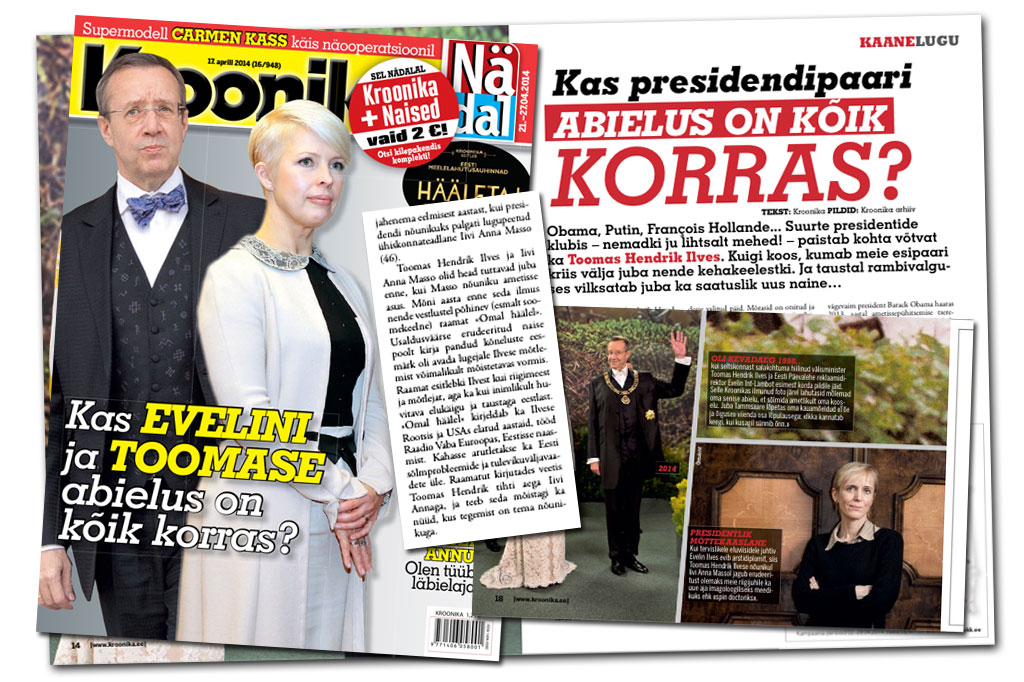
I understood that the Press Department had given me bad advice. It turned out that unlike me, Sildam had known about the story in advance. He mentioned casually that a previous version of the article had not been quite that bad. I can’t recall the exact wording, but he revealed that he had seen a previous version. He had known it was coming. Even much later, when it was obvious how much damage the rumour had caused, Lensin refused to tell me where it had come from. She said in an e-mail: “Regardless of the truthfulness of the information they gave me, I’ll never reveal my sources, not to you, not to anyone”.
However, some of my colleagues claimed to know why I’d been picked as the target of the story. “That was just random, it wasn’t meant to attack you. You were just collateral damage. You were picked out because there were photos of you and the President”. Thus spoke Ülle Madise, the President’s legal adviser, now the Chancellor of Justice of Estonia, meaning photos from a book launch ceremony where the author and editor of the book were both present. She appeared very sure about it.
How could she know, if the Kroonika editor did not share her sources with anyone? I heard the same sentence from several other people, including people dealing with internal security. “It was not meant as an attack against you, you were just collateral damage.” Several people, all separately, used the exact same words. Why?
After the rumour was thrown into the media, my journalist friends told me about their colleagues who insisted they “knew for sure” that I had an affair with my boss, and that the “information” had come directly from the Castle. Some even insisted I myself was spreading it. To counter any such claims, I sent an e-mail to all my colleagues in which I took distance from the rumour and suggested we should react to it. The only person in the Castle who agreed with me was Mrs. Ilves. Another colleague, the head of foreign policy department, responded by sending me a long e-mail at midnight, full of more or less veiled threats: she told me I was “hurting myself, and not a little” and “making enemies”. She professed: “If your relationship with the big boss gets sour it’ll become relatively pointless to keep on working here”. Even under the circumstances, that sounded odious, as I assumed that the trust that formed the basis of my work relationship with the President would remain untouched by the rumour.
*
I went on working for the President for nearly another year. Every now and then I still heard that people “knew for sure” that I was having an affair with him, some insisted he had already left his wife and we were living together. In reality, it was harder and harder for me to get a five minute audience with my boss to collect his thoughts for the speeches I’d help him draft. The Castle was full of poison.
In January 2015 I attended, by the invitation of the Embassy of Finland and the Finnish Institute of International affairs, a seminar in Helsinki on Finnish and Estonian foreign policy. I gave a brief panel talk there. It was an open event, with the media present. I gave a couple of brief interviews, to Hufvudstadsbladet and Yle. That seemed to wake up the Finnish propagandists who had not paid attention to me for a while. Someone posted one of those interviews in a public Facebook group, and soon a fake account (under the name of a dead Finnish politician) was repeating in the comments section: “She is just the president’s mistress!” Obviously, there was a need for some info warriors to belittle any political message I could have had.
Some days later a mutual friend saw a blog entry posted in Facebook by Risto Vuorinen who worked for Yle, the Finnish public broadcaster, as a freelance correspondent in Estonia. The blog post was about an earlier minor diplomatic quarrel about a statement made by the Finnish foreign minister Erkki Tuomioja on Russian language media in Estonia (he’d claimed there was none, which was not true, and the Estonian Ambassador had discussed the issue with him). The blog text was abusive, propagandist and vulgar in style, attacking the people the blogger claimed were behind the quarrel – President Ilves, the Estonian Foreign Minister Keit Pentus-Rosimannus, Estonia’s Ambassador to Finland Margus Laidre and me. It contained vile slander about all of us. It painted me as an architect of the quarrel – in fact I’d had nothing to do with it, advice about diplomatic relations was not part of my job description. It also referred to me, twice, as the President’s “girlfriend”, citing “Estonian papers” as the source. Indeed – none of the papers that had published the rumour had publicly corrected their claims. Neither had the Castle denied them.
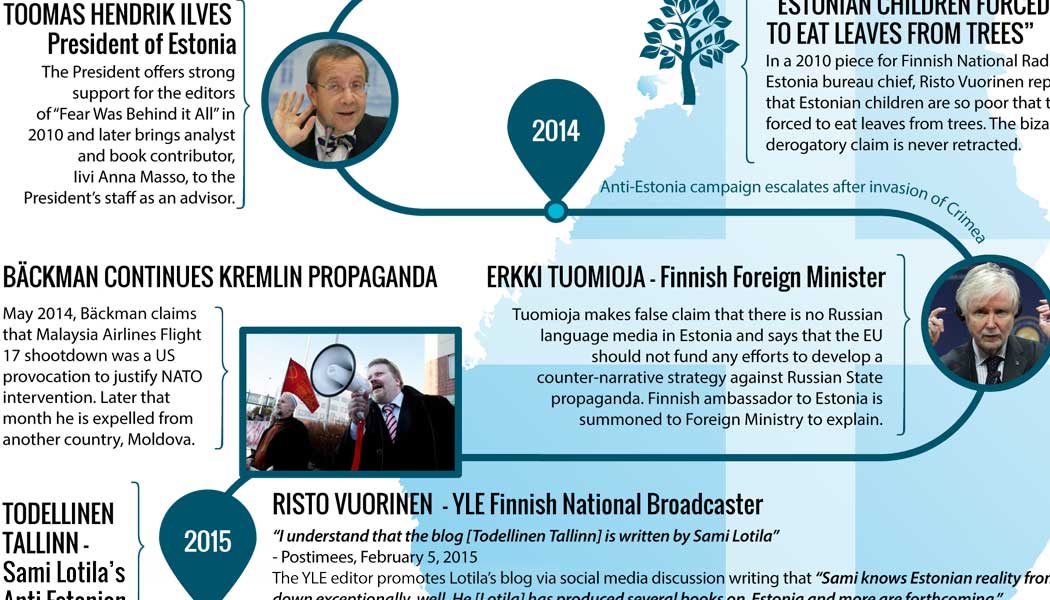
Extending the false rumour to Finnish public spaces was more than I agreed to go on bearing silently. Toomas Sildam had insisted it would go away by itself. Now we saw it hadn’t; it was now being spread internationally. It turned out the libelous blog post had been written by Sami Lotila, a well-known Estonia hater. Vuorinen was challenged about it on his Facebook timeline and he defended it, calling Lotila the best expert on Estonian affairs. I could not argue with Vuorinen on his Facebook timeline to which I had no access. I had once given him an interview, so I was baffled he’d spread such insults about me and Estonia’s leaders behind my back. I wrote on my own Facebook page, to warn my friends, that Vuorinen was spreading Kremlinite propaganda and it would be best to ignore him should he ask for an interview. People tried to share my warning, so I made it public. And I wrote a short version on Twitter.
*
After that, a storm broke out. An Yle editor attacked me for trying to silence foreign news media from a power position (my Twitter account carried a note that my tweets expressed strictly personal views only, no one had ever quoted them before). Then the Estonian media attacked me for harassing the poor journalist. No one asked how ethical it was for a foreign correspondent to spread malicious rumors and vulgar abuse about the President, Foreign Minister, Ambassador and a member of the President’s staff in the country of his posting.
Estonian papers kept up the attack for weeks. I agreed to one interview and one radio show to present my side of the story. The Castle did not like it, but they declared to the public that the “tweet issue” would not affect my work. (Interestingly, half a year later, Vuorinen wrote a biased story on the kidnapped Estonian police officer Eston Kohver, and a spokesman for the Estonian security police said, in the same wording I had used, that Vuorinen “spread Kremlinite propaganda”. No one attacked him for the statement and no one questioned his right to carry on doing his job.)
During the media attacks I became more and more isolated and ostracized in the Castle. I got the impression that my colleagues disliked not what I had said about the Finns’ writings – I assume they agreed with me on that – but the fact that I was finally speaking up against the rumour about the affair, after nearly a year of silence. They asked me to stop defending “my interests” – that was how the Director of our office put it in an e-mail. I replied: “You did not refute the gossip. If I am not allowed to refute it either, then let us find out where it came from. Why did Sildam not warn me about it? Why do so many journalists insist it came right from the Castle? Why did Kaarelson send me a threatening letter when I took distance from the rumour?”
It was the following work day that I was expelled from my workplace, with no warning, no discussion, no explanation, no official reason – the position was just terminated overnight as “unnecessary”; no chance to talk to my boss who had only ever given positive feedback for my work. Having first been publicly labeled a paid mistress, I was eliminated and made persona non grata for trying to resist the label.
*
President Ilves divorced his wife in April 2015, shortly after I was expelled from my job. Another round of the rumour was thrown at me by the media; again I was blamed for the First Couple’s divorce for just the crime of working in the Castle. I never knew what was going on between them. I never talked private life with my boss.
Having first been publicly labeled a paid mistress, I was eliminated and made persona non grata for trying to resist the label.
For a while after his divorce, the President was only photographed at official events alone or with his children. In September 2015 he brought a female companion to the limelight, attending maestro Arvo Pärt’s 80-year anniversary concert with a stylish Latvian, Ieva Kupce. It was a well-planned media performance, the message had to be clear. The media rushed to reveal details about Kupce: where she works, the property she owns. As for family status, she was said to be single and have a child. For some reason none of the media mentioned her second child that was born in 2014. In early December, the papers announced that President Ilves had got engaged with Ieva Kupce in the middle of November.

The President’s staff knew well that this “new” friend had been around for years. They spent time together and appeared close. Sometimes outsiders asked us: who is that mysterious Latvian woman? We just mumbled: “an old friend”. When the gossip media first noticed Kupce, they’d spotted the already divorced President meeting her in Riga. Then, the President’s PR adviser told the media he had no idea who the woman was. After the public introduction he too described her as “an old friend”.
The calculated media presentation of Ms. Kupce as the President’s new companion brought back some unanswered questions. Could it be that during my journey from the story about the invented affair thrown to the media to my expulsion from the Castle, I was not lied to as much as I had thought I’d been? Could it be that the references to “collateral damage” whose meaning I did not grasp at the time, implied that the President’s close circle had created a bogus scandal to avoid awkward questions? Could it indeed be, as my colleagues had insisted, that I was chosen at random, as a byte to the media to avert a real scandal? Could it be, in other words, that the Castle would sacrifice an adviser to the President just to keep an actual relationship from becoming public too soon, have her smeared all over the press and then expelled when it turned out the whole story wasn’t just smoothly forgotten?
Some people know the answers. I only know that this interpretation makes most sense of a story that does not make any sense. It would explain the Castle’s otherwise inexplicable refusal to refute the libel. Normally Sildam would ask editors to correct or take down obvious disinformation – I knew; my office was next to his. It would explain why I was expelled not after I criticized the slandering journalists, as the public was led to believe, but after I demanded that the origins of the gossip be revealed.
For a long time I had a Kafkaesque feeling in the Castle that I was doomed without knowing why; I didn’t know who lied to me, who kept something from me, who knew about the rumours but wouldn’t tell. There could be reasons behind the gossip I still have no clue about. But even if it was not a conscious effort by my colleagues to save the President from a scandal, but just a work of some petty people I’ll never identify, the fact remains that the Castle refused to refute the lie, allowed it to spread, and then dismissed me for no longer agreeing to take it silently after nearly a year.
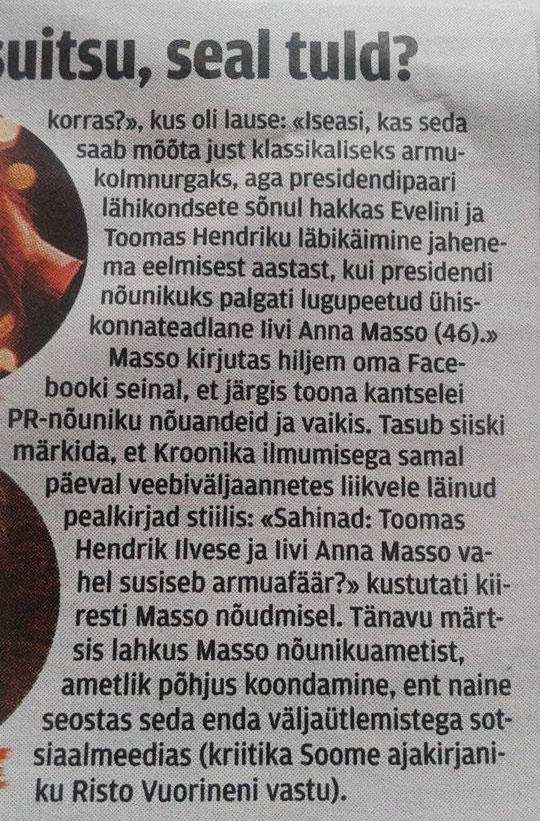
*
The most vicious of old proverbs is “where there is smoke, there’s fire”. You throw a lie out to the world and people assume there must be some truth to it. This sentence was a headline in the Estonian Õhtuleht on September 17 2015, after the President introduced his new companion to his people, of a story once again labeling me a former mistress. I got it when it was first invented, and again when the First Couple divorced, and again when a potential Mrs. No. 3 was brought into the limelight. The paper once again reprinted the libelous gossip that had been published before, implying, again, that it must be true. So even when all things were settled for the parties involved, the media once again took a chance to erase the work I had done and seal my status at my now former workplace as just a discarded mistress.
The moral of this story goes beyond an interrupted career and a smeared reputation. We still need to use the caution some of us learned in the Soviet times: you cannot assume that media will stick to facts; you must retain persistent skepticism, even at the expense of your trust in the reliability of the world, the chance to know anything.
The silence that followed my public humiliation was deafening. Many people knew that what was said was not true, that I was smeared for no reason, but no one ever commented the issue. There is a schoolyard bully attitude in Estonia: you better side with the big boys or at least keep quiet, lest you end up as their next victim.
This also means that people have a more complicated relation to truth than all the talk about information wars would have us believe. A clearly defined opponent like the “Kremlin trolls” is easy to spot and defy. It is different when the destruction comes from what is supposed to be your own side. Hannah Arendt noted in her essay “Truth and Politics” that facts, as opposed to mathematical truths, can be lied out of the world. In endless info flows, whatever has been said remains out there, and any alternative version is just a competing claim, neither more nor less credible. Ironically lies, as Arendt wrote, represent freedom to a greater extent than factual truth, as they have the power to change the world instead of just describing it. The liar is in a privileged position, he has endless liberty in creating his version of a story, and thus more chances to please the listener. Paraphrasing Thomas Hobbes, Arendt wrote in 1967: “Factual truth, if it happens to oppose a given group’s profit or pleasure, is greeted today with greater hostility than ever before”. This is equally true today, also in societies classified as free. Fiat veritas, et pereat mundus never was a popular principle – for what is seen as a greater good, a little “collateral damage” always goes a long way.

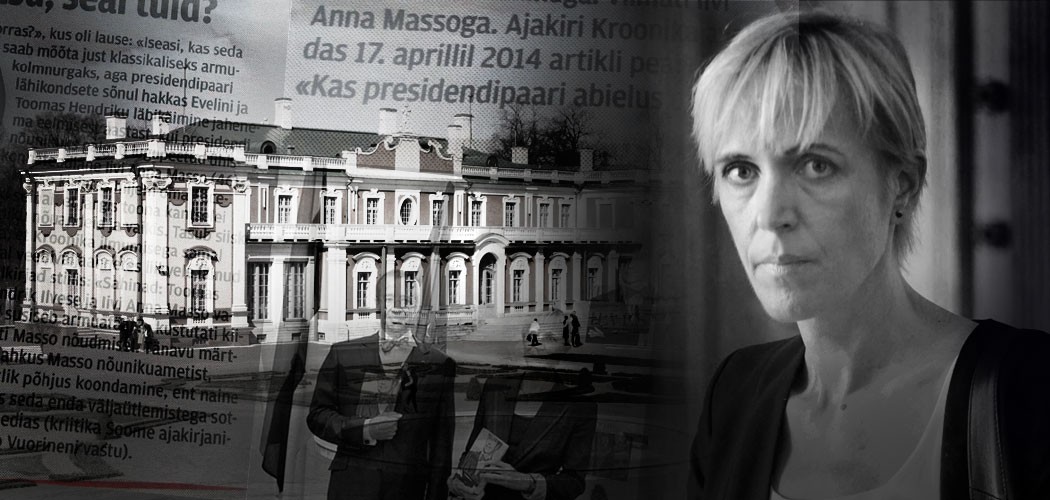
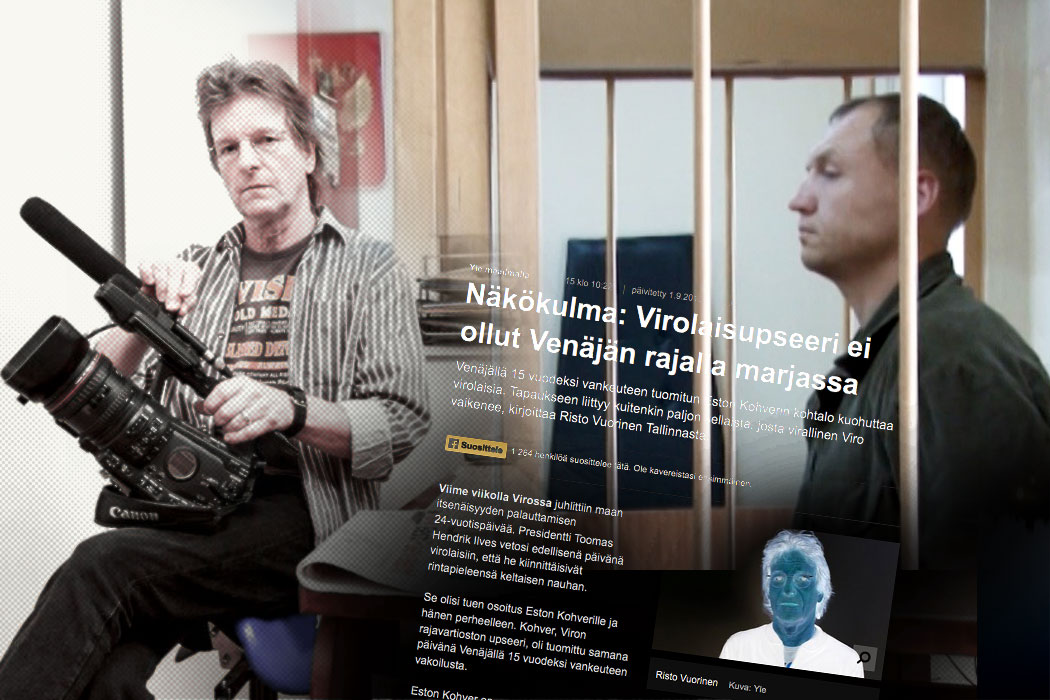

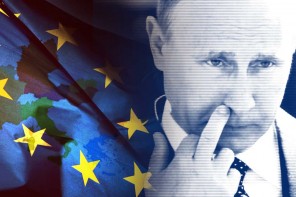

Castle Kafkaesque. Inglorious Cass Sunstein. Infowars and psyops. ’Harder and harder for me to get a five minute audience with my boss… the Castle was full of poison’. Two Toms of Estonia (not Finland). ’Expelled from my workplace, with no warning, no discussion, no explanation, no official reason.’ Public relations adviser used to work for the KGB.
Ah, what a turgid résumé of Tom’s (versus old-timer Arnold’s) forward-looking, ’transparent’ Estonia! If only we’d known. As a former Toronto Estonian, now living in ’the Homeland’, and with my own axe to grind with the President’s Office, possibly with that same KGB Tom (starting with the insultingly elliptical non-answer I once got to my public letter, asking which of the two swine flu vaccinations Estonia was to be receiving: the ’original’ suitable for the Swiss army, or the quickly mass-produced one with the adjuvant ’squalene’? Answer: ’Our’s complies with international health standards’ – well of course, officially both did!! Ha-ha, joke’s on me…) for the record, I’m wondering what was the Estonian term used for ’collateral damage’?
Lembit Tork, architect.